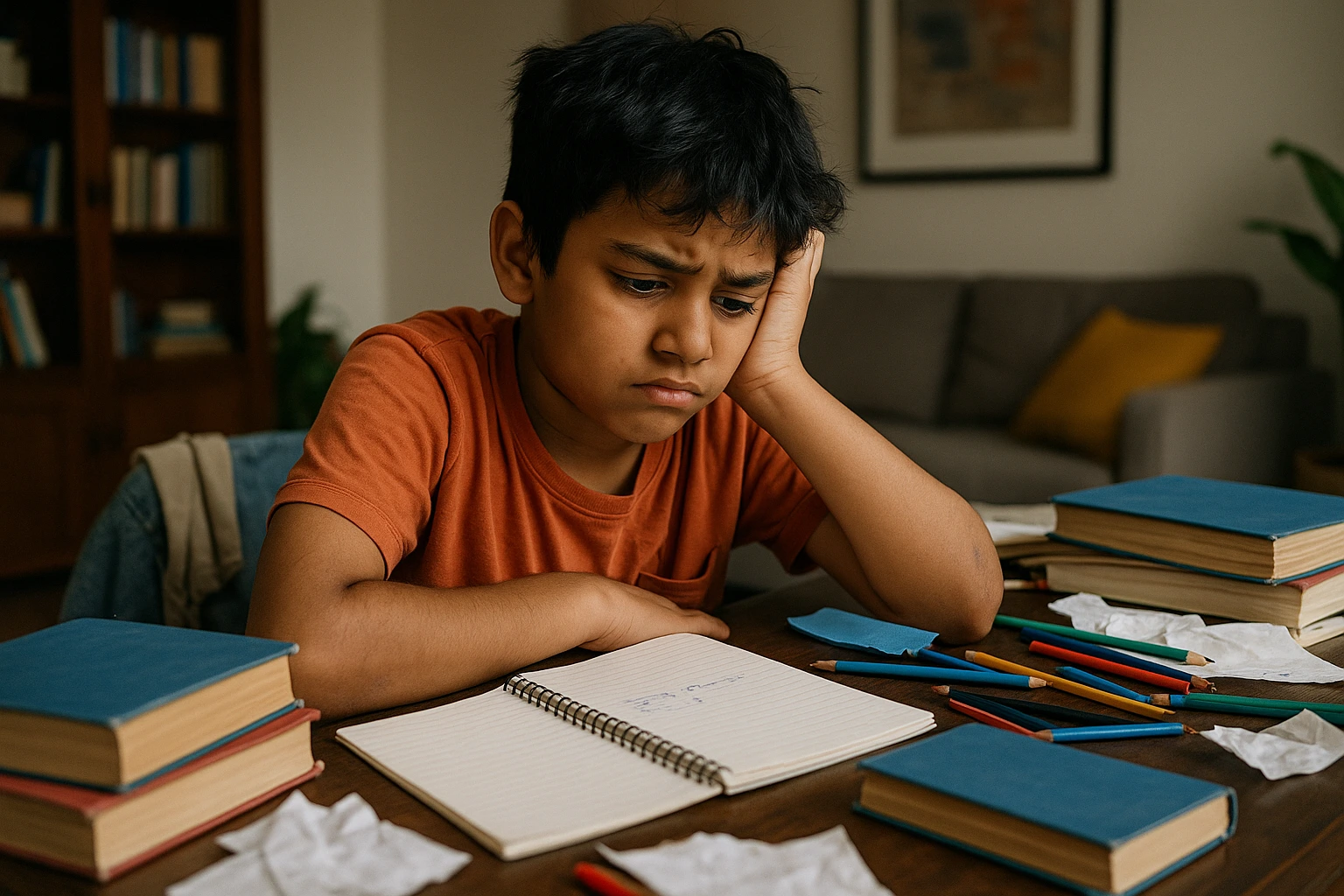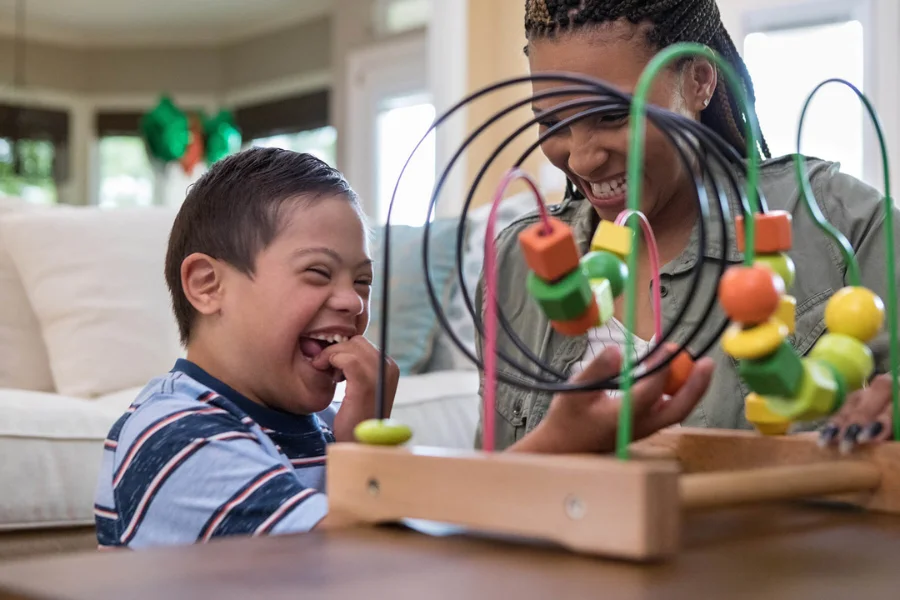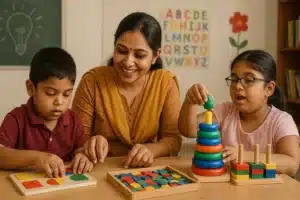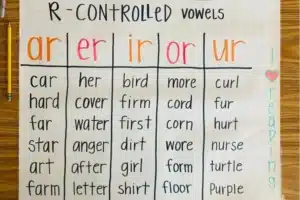
ADHD, or Attention-Deficit/Hyperactivity Disorder a neurological condition that impacts the most crucial skills of the child that are formed during his early years. When a child starts their academic journey, these important skills, such as focusing, sitting in one place, and concentration, are required. Signs of ADHD in Kids affects main competencies, including the ability to sit quietly and manage their emotions effectively. This disorder affects the learning skills of the child as well as their behaviour, leading to poor relationships.
Early recognition Signs of ADHD in Kids can be of great advantage for the child as it helps to begin the remediation process that helps to address the areas of challenges and helps him accommodate comfortably into a regular classroom.
ADHD Symptoms in Kids
ADHD shows up in different ways, and children may show one or more types of symptoms. The behaviours affect their learning, social relations, and daily work. The awareness of symptoms facilitates an understanding of whether a child will require help. Signs of ADHD in Kids is mostly divided into three types, which are Inattentive, Hyperactive-Impulsive, and Combined.
To download the Brochure of the SEN Course, Click Here!
For more details of SEN Course Call / Whatsapp on +919321024137 / +919869866277
Inattention
Children with this type of ADHD may struggle to stay focused or follow instructions.
Common signs include:
- Difficulty paying attention to details
- Easily distracted, even during play
- Trouble organizing tasks or belongings
- Frequently loses items like school supplies or toys
- Avoids or dislikes tasks that require focus for a long time
- Forgetful in daily activities
Hyperactivity
Hyperactive kids may seem like they are always on the move.
They often:
- Fidget or squirm when seated
- Have trouble staying seated during class or meals
- Run or climb at inappropriate times
- Talk nonstop or make excessive noise
- Struggle to play quietly
Impulsivity
This type affects self-control.
Children with impulsivity may:
- Interrupt conversations or games
- Blurt out answers before a question is finished
- Struggle with waiting for their turn
- Act without thinking about the outcome
Combined ADHD
Many children show symptoms of both inattention and hyperactivity-impulsivity. This is called Combined ADHD. These kids may have trouble focusing, staying silent, and controlling their instincts all at once.
Each kid is different, and symptoms can change over time. Identifying these patterns initially can make it easier to provide the right support.
To download the Brochure of the SEN Course, Click Here!
For more details of SEN Course Call / Whatsapp on +919321024137 / +919869866277

Diagnosing ADHD in Kids
Diagnosing ADHD in children involves not just observing behaviour. It needs a detailed estimate to understand whether the signs point to ADHD or something else. Several children display gestures that can be highly interrupting or too much energy. But these signs do not necessarily imply that the child has ADHD. For an ADHD diagnosis, these behaviours must be recurring, noteworthy, and disrupt the entire classroom environment, impacting his academic progress and ability to form friendships.
Who Can Diagnose ADHD?
A proper identification is typically made by professionals with experience in kids’ behaviour and development, with:
- Paediatricians
- Child psychologists
- Child psychiatrists
- Neurologists
- Trained clinical social workers
ADHD detection does not rely on one single test. The process involves conducting several informal assessments through which information is noted, and only when substantial information is collected, a diagnosis is made. Early and correct diagnosis helps children get the right support and strategies to manage symptoms effectively.
ADHD Behaviour vs. Neurotypical Behaviour
Knowing the accurate difference between neurotypical behaviour and ADHD behaviour helps the different stakeholders of the child’s journey provide the appropriate support needed to address the real causes of the behaviour. Educators and parents gain clarity about the child’s problem areas, which helps them handle them with proper care and precise techniques for better results.
Here’s a comparison to highlight the differences:
Attention and Focus
Neurotypical
Can usually focus on tasks suited to their age, especially if they are interested. May get distracted occasionally, but can return to the task.
ADHD
Struggles to keep attention even on enjoyable activities. Frequently loses focus, misses details, and avoids tasks that require focus.
Activity Level
Neurotypical
Can sit silently for certain age periods. May get restless, but can usually manage physical movement based on the setting.
ADHD
Constant movement, even when seated. May fidget, tap, or leave their seat in quiet settings like a classroom or dinner table.
Impulse Control
Neurotypical
Can generally wait their turn, think before acting, and follow basic rules most of the time.
ADHD
Acts or speaks without thinking. Interrupts often, has trouble waiting, and may react strongly in emotional situations.
Organization and Memory
Neurotypical
Can learn routines and follow instructions with some reminders. May forget things occasionally, but can usually manage tasks.
ADHD
Very often does not recollect what tasks must be done, is disorganised with his belongings lying on the floor, and unfinished assignments.
Emotional Responses
Neurotypical
Can show emotions with growing self-discipline as they mature.
ADHD
The child is frustrated as he cannot focus or sit relaxed, which later transforms into fidgeting behaviour, causing chaos in the classroom.
Many times the above patterns go undeciphered under the pretext of lazy behaviour or naught attitudes that cause delays in helping the child get the right support. Understanding these symptoms helps to get a formal assessment done to determine whether the child needs support.
To download the Brochure of the SEN Course, Click Here!
For more details of SEN Course Call / Whatsapp on +919321024137 / +919869866277

Source: istockphoto
ADHD Treatment
ADHD impacts the different attributes of a child, namely attention, concentration, and impulsive behaviour. So when ADHD has to be treated, it incorporates a combination of therapies, techniques, and methods that help treat academic as well as behavioural challenges.
For ADHD, no set defined method can take care of all the challenging aspects, as each child has different issues and needs.
Special Educators observe the child and assess their competencies and weaknesses accordingly, devising a strong, impactful approach that helps children with ADHD manage their struggles and attain their goals in different environments.
Common Treatment Approaches Include:
Behavior Therapy
This approach is mostly centered around helping the child understand his emotions and learn to handle the triggers that lead to disturbing behaviour. Parents are educated in essential techniques such as maintaining visual schedules, using a reward system to help children be calm and composed in social atmospheres.
Medication
There are extreme cases of ADHD in which the doctors prescribe medicines that help the child remain calm, helping them improve their focusing power and retain their energy productively.
Parent Training and Support
Parents gain precise knowledge of various strategies and techniques that help to promote learning at home and help them calm down for emotional regulation.
School Concessions and Benefits
Children with learning disabilities are entitled to various benefits, concessions, and IEPs that can be beneficial for their long-term academic journey.
Emotional Wellbeing Counselling
ADHD affects the emotional health of the child. Through counselling, the child receives the desired support to manage their burnout and understand what triggers them, leading to disruptive behaviours.
Aspiring candidates who aim to establish a path-breaking career in the field of Special Education must enrol in s Special Education needs course from a trusted platform of Vidhyanidhi Education Society (Govt. Regd.) that has launched a top-notch program devised by leading professionals with valuable work experience of many years.
This program helps candidates and parents be well-versed with tools and strategies that help them cater to the diverse learning needs of children, building inclusive and conducive atmospheres.
The Special Education Needs Course includes practical methods for classroom management, behaviour support, and individualized instruction skills that are important for working with children with ADHD. By joining the Special Education Needs Course offered by Vidhyanidhi Education Society (Govt. Regd.), teachers and parents gain the knowledge needed to make a long-term difference in a child’s learning journey.
Master ADHD categories! Enroll in Vidhyanidhi’s Special Education Needs Course today!
To download the Brochure of the SEN Course, Click Here!
For more details of SEN Course Call / Whatsapp on +919321024137 / +919869866277
FAQs
What Age Does ADHD Peak?
The actual onset of ADHD is at 6 years, but the symptoms start showing as early as 3 years and get more evident during the early years as school starts.
Does Childhood ADHD Go Away?
For some, ADHD symptoms may lessen with age, but many continue into adolescence and adulthood. Support and early intervention through their Special Education Needs Course offered by Vidhyanidhi Education Society helps manage this.
Does ADHD Affect Sleep?
Yes, ADHD makes the child restless as he cannot sit in one place for a long duration, which leads to poor sleep patterns.



